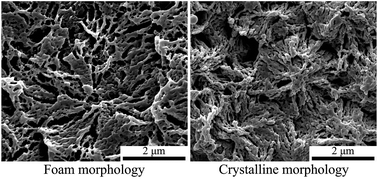Poly(L-lactic acid) (PLLA) foams with unique nanocellular and needle-like morphology were successfully prepared by combining spherulite templating and supercritical carbon dioxide (CO2) foaming. The corresponding crystalline morphology formed under supercritical CO2 in PLLA was illustrated to investigate the foaming behavior of spherulites in detail. It was found that not only the degree of crystallinity but also the crystalline morphology played a vital role in cell nucleation and growth, thus the foam morphology. Nanocellular structure was primarily generated for the PLLA foamed at 100 °C and 12–24 MPa. Moreover, the morphological transition from approximate circular cells to needle-like cells occurred around 16 MPa at 100 °C because of the constraint of lamellae, and the two different structures coexisted at 100 °C and at pressures ranging from 16 to 24 MPa. The results indicated that the expansion ratio of spherulite was bigger than that of PLLA foam.

